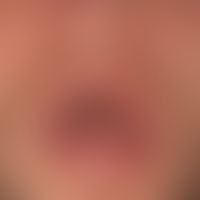Image diagnoses for "Skin defects (superficially, deep)"
175 results with 456 images
Results forSkin defects (superficially, deep)

Porphyria cutanea tarda E80.1
Porphyria cutanea tarda: close-up. older scars marked by stars. vertical arrows: encrusted erosions after traumta; vertical arrows: bulging (subepithelial - the entire epidermis forms the firm bladder roof) fresh areactive blisters (the blisters appear as if from nowhere. no signs of inflammation!)
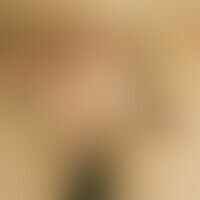
Carcinoma verrucous (overview) C44.L
Carcinoma, verrucous, cauliflower-like, ulcerated tumor in the genital region with right-sided lymph node metastasis that has existed for years.

Gaiter ulcer I83.0
Largeulcer of the left lower leg and back of the foot in a 63-year-old female patient with CVI known for 20 years after several split skin transplants.
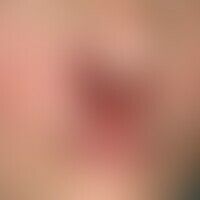
Basal cell carcinoma destructive C44.L
Basal cell carcinoma, destructive: ulcer measuring approx. 3 x 4 cm with glassy papules strung together like a string of pearls. 64-year-old female patient.

Aphthae (overview) K12.0
Habitual aphthae: approx. 3 cm in size, progressive for 10 days, solitary, very painful aphthae.

Porphyria cutanea tarda E80.1
Porphyria cutanea tarda: back of the hand and dorsal forearms with small papules, excoriations and older scars and hyperpigmentation. no fresh blisters. palms free of irritation.
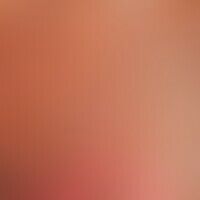
Toxic epidermal necrolysis L51.2
Toxic epidermal necrolysis. detailed picture: The 67-year-old female patient developed multiple, acute, disseminated, sharply demarcated, partly confluent, soft, skin-coloured blisters on a flat erythema on the entire integument within a few days. In case of persistent fever, antibiotic therapy was initiated.

Zoster in the trigeminal region B02.8

Behçet's disease M35.2
For 21 days persistent, 2 ca. 0.5 cm large, aphthous, whitish, smearily covered, strongly painful ulcers on the right large labia in a 42-year-old Ethiopian woman.
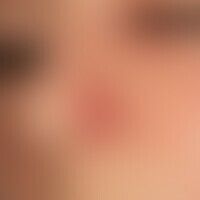
Basal cell carcinoma nodular C44.L
Basal cell carcinoma, nodular. solitary, 1.0 x 1.2 cm large, broad-based, firm, painless nodule, with a shiny, smooth parchment-like surface covered by ectatic, bizarre vessels. Note: There is no follicular structure on the surface of the nodule (compare surrounding skin of the bridge of the nose with the protruding follicles).
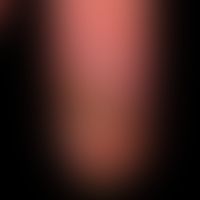
Thrombangiitis obliterans I73.1
Thrombangiitis obliterans (endangiitis obliterans): peripheral circulatory disorder with acutely occurring ulcers, which are now already older and covered with crusts.

Erythema multiforme, minus-type L51.0
Erythema exsudativum multiforme, map-like, highly painful erosions of the tongue.
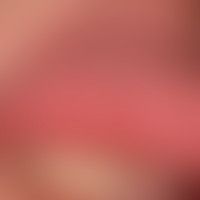
Early syphilis A51.-
Syphilis: Primary effect; rough, non-painful ulcer (DD: aphthae); raised marginal wall.

Atopic dermatitis (overview) L20.-
eczema, atopic. chronic, recurrent, itchy, red spots as well as slightly raised, rough, red plaques on the forehead of an 8-month-old girl. furthermore multiple, disseminated, partly crusty scratch excoriations. fine-lamellar scaling in the region of the nose

Lichen planus vulvae L43.9
Lichen planus of the vulva: itching for months. 35-year-old female patient with veil-like white discolouration of the large labia marked by arrows. Fig. from Eiko E.Petersen, Colour Atlas of Vulva Diseases, with the permission of Kaymogyn GmbH Freiburg.

Prurigo simplex subacuta L28.2
Prurigo simplex subacuata: typical distribution pattern of the interval-like itching, scratched, inflammatory papules and plaques.

Toxic epidermal necrolysis L51.2
Toxic epidermal necrolysis. emergency hospitalization of a highly febrile (temp. 39.5 °C) 78-year-old woman with hemorrhagic, areal, epidermal necrolysis in the area of the left arm after ingestion of vancomycin. significantly reduced general condition. it turned out that the patient had received allopurinol and ampicillin for the first time a few days before.
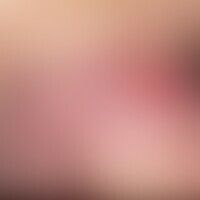
Early syphilis A51.-
Syphilis acquisita: two sharply defined, surprisingly coarse, completely indolent, red, yellowish ulcers in a 32-year-old husband that have been present for 14 days; secretion of an irritant secretion; indolent regional lymphadenitis (Bubo).
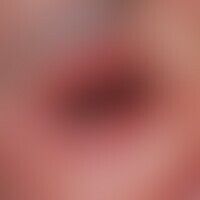
Toxic epidermal necrolysis L51.2

Artifacts L98.1
Artifacts: multiple, non-itching, flat, pyodermic ulcers up to 2.0 cm in diameter in an otherwise completely healthy patient, occurring anew without apparent reason. the new occurrence of skin changes cannot be plausibly justified. reasons different and not comprehensible. manipulation is strictly negated.

